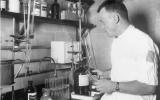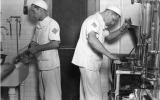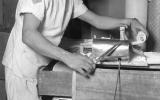CPS Unit Number 061-01
Camp: 61
Unit ID: 1
Title: Duke University Hospital
Operating agency: MCWP
Opened: 12 1942
Closed: 10 1946
Workers
Total number of workers who worked in this camp: 65
-
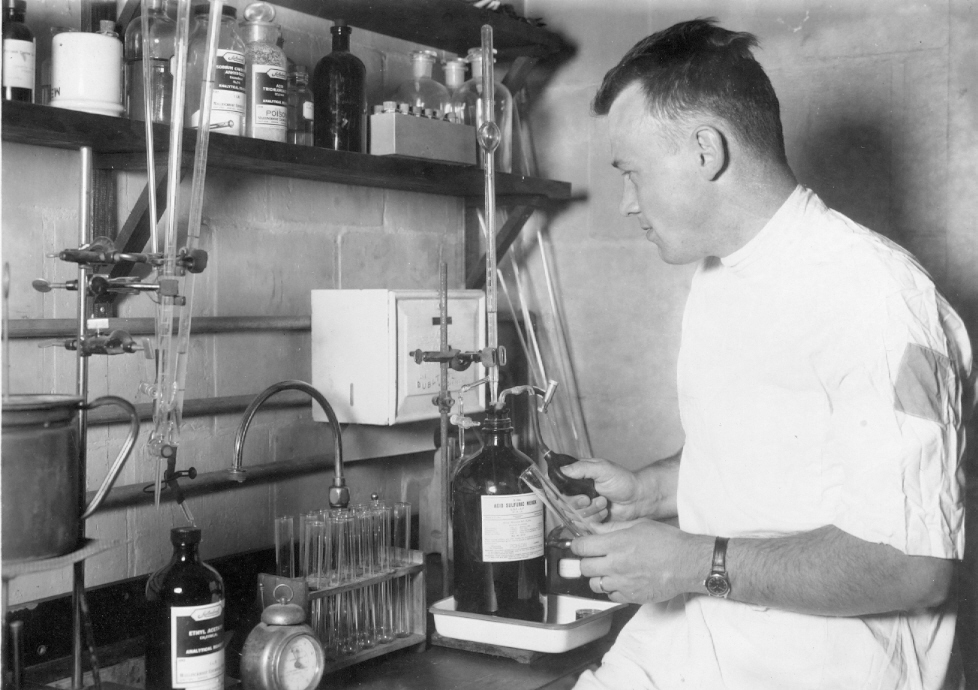 CPS Camp No. 61, Durham North Carolina.A degree in chemistry and work as an industrial chemist prepared Truman Kirkpatrick, Methodist, from Chicago, Ill., for his present work in Blood-Chemistry. He also helps run the electroencephalographer.Digital Image © 2011 Brethren Historical Library and Archives. All Rights Reserved.
CPS Camp No. 61, Durham North Carolina.A degree in chemistry and work as an industrial chemist prepared Truman Kirkpatrick, Methodist, from Chicago, Ill., for his present work in Blood-Chemistry. He also helps run the electroencephalographer.Digital Image © 2011 Brethren Historical Library and Archives. All Rights Reserved. -
 CPS Camp No. 61, Durham North Carolina.Instrument, basin and water sterilizers are kept clean by C.P.S "attendants". Cleaning an instrument sterilizer is Harold Clark, Methodist, from Minneapolis, Minn.; and cleaning a suction jug is William Kriebel, Friend, from Philadelphia, Pa. (These two men are the editors of "Service", mimeographed publication of the Duke unit).Digital Image © 2011 Brethren Historical Library and Archives. All Rights Reserved.
CPS Camp No. 61, Durham North Carolina.Instrument, basin and water sterilizers are kept clean by C.P.S "attendants". Cleaning an instrument sterilizer is Harold Clark, Methodist, from Minneapolis, Minn.; and cleaning a suction jug is William Kriebel, Friend, from Philadelphia, Pa. (These two men are the editors of "Service", mimeographed publication of the Duke unit).Digital Image © 2011 Brethren Historical Library and Archives. All Rights Reserved. -
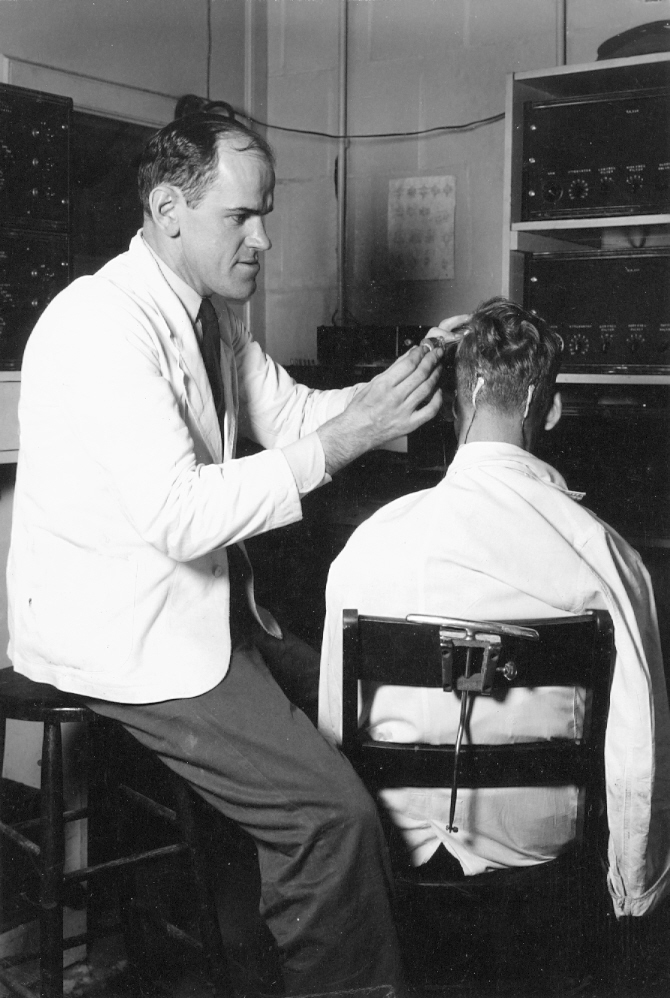 CPS Camp No. 61, Durham North Carolina.William McLaughin, Presbyterian, from Alliance, Ohio, spend most of his time (a small part on Meyer Ward) operating the electroencephalograpgh machine. Tiny electrical currents in the brain are amplified by a battery of electrical amplifiers and recorded on a paper tape as wavering lines. With the help of such records, experts (doctors) diagnose abnormalities, such as brain tumors. Bill is shown attaching the "brain-wave machine" electrodes to a patient.Digital Image © 2011 Brethren Historical Library and Archives. All Rights Reserved.
CPS Camp No. 61, Durham North Carolina.William McLaughin, Presbyterian, from Alliance, Ohio, spend most of his time (a small part on Meyer Ward) operating the electroencephalograpgh machine. Tiny electrical currents in the brain are amplified by a battery of electrical amplifiers and recorded on a paper tape as wavering lines. With the help of such records, experts (doctors) diagnose abnormalities, such as brain tumors. Bill is shown attaching the "brain-wave machine" electrodes to a patient.Digital Image © 2011 Brethren Historical Library and Archives. All Rights Reserved. -
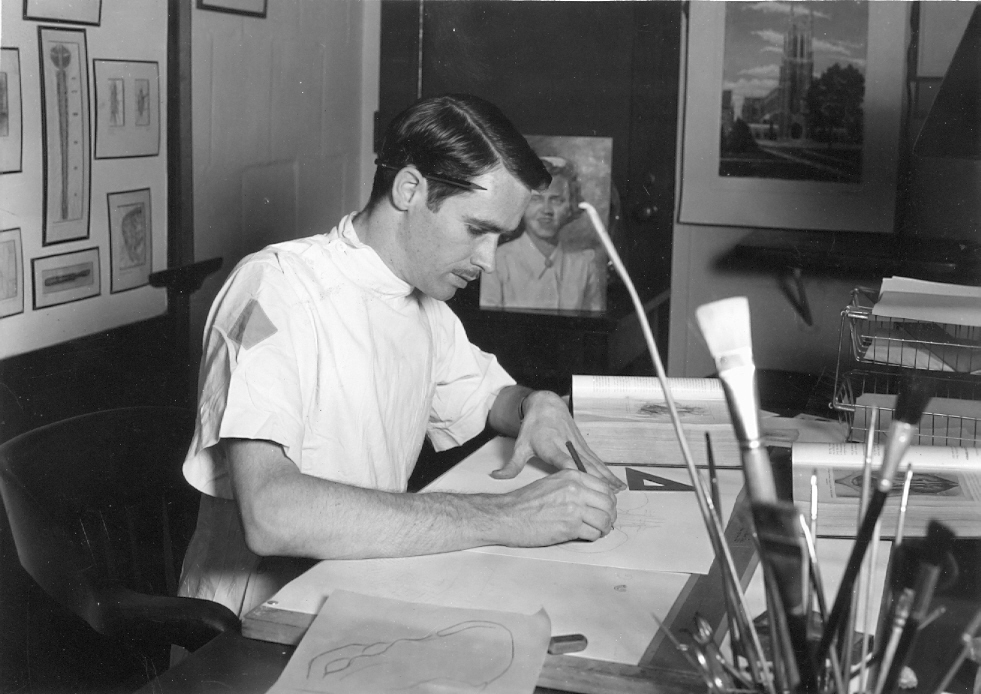 CPS Camp No. 61, Durham North Carolina.A professional artist prior to coming to C.P.S., Robert Blake, a Methodist, from Upper Darby, Pa., spent only 3 months in the O.R. before his talent was utilized as a medical artist in the illustration dept. of Duke Hospital. He makes charts, diagrams, lantern slides and drawing for teaching purposes, and also for illustrating medical books and research publications; takes and shows movies, etc. On the wall to the right of Bob's head are water-colors of his wife (a nurse) and of Duke U. Chapel, done in spare-time. The series of pictures from which this picture came are Bob's work. Ditto covers and drawings in "service", the unit publication.Digital Image © 2011 Brethren Historical Library and Archives. All Rights Reserved.
CPS Camp No. 61, Durham North Carolina.A professional artist prior to coming to C.P.S., Robert Blake, a Methodist, from Upper Darby, Pa., spent only 3 months in the O.R. before his talent was utilized as a medical artist in the illustration dept. of Duke Hospital. He makes charts, diagrams, lantern slides and drawing for teaching purposes, and also for illustrating medical books and research publications; takes and shows movies, etc. On the wall to the right of Bob's head are water-colors of his wife (a nurse) and of Duke U. Chapel, done in spare-time. The series of pictures from which this picture came are Bob's work. Ditto covers and drawings in "service", the unit publication.Digital Image © 2011 Brethren Historical Library and Archives. All Rights Reserved. -
 CPS Camp No. 61, Durham North Carolina.Part of the job of the C.P.C. attendant in the orthopedics service in the operating rooms is "making plaster" - the rolls of plaster-of-paris and crinoline that are used in making plaster casts, both in the O.R. and in the orthopedic clinic - some has also been supplied at times to small hospitals and clinics in N. Carolina. Shown at work is Harold Kleiner, Methodist, from Portland, Oregon. Until he transferred in Sept. 1943, to Alexian Bros. Hospital, Chicago, this job belonged to Lowell Herberger, Mennonite, from Nappanee, Indiana.Digital Image © 2011 Brethren Historical Library and Archives. All Rights Reserved.
CPS Camp No. 61, Durham North Carolina.Part of the job of the C.P.C. attendant in the orthopedics service in the operating rooms is "making plaster" - the rolls of plaster-of-paris and crinoline that are used in making plaster casts, both in the O.R. and in the orthopedic clinic - some has also been supplied at times to small hospitals and clinics in N. Carolina. Shown at work is Harold Kleiner, Methodist, from Portland, Oregon. Until he transferred in Sept. 1943, to Alexian Bros. Hospital, Chicago, this job belonged to Lowell Herberger, Mennonite, from Nappanee, Indiana.Digital Image © 2011 Brethren Historical Library and Archives. All Rights Reserved.
CPS Unit No. 61, a General Hospital unit located at Duke University Hospital in Durham, North Carolina operated by the Methodist Commission on World Peace, opened in December 1942 and closed in October 1946. Most of the men worked as orderlies and attendants.
CPS unit No. 61 was located at Duke University Hospital, in Durham, North Carolina as well as at an affiliated psychiatric unit located at Highland Hospital in Asheville, North Carolina.
Director: Paul Brotsman, W. B. Kriebel, Louis Swanson
Sixty-eight men rotated through this unit and made a major contribution to hospital operations. Several wives worked as well.
The men brought education and skills to their work. During the first year of unit operation, the hospital administration recognized that these highly educated lay persons had potential to perform clinical duties well beyond the minimum requirements of an attendant’s position.
- One man with personnel experience typed patient histories.
- One with background in photography and art, with another CPS man, prepared charts, drawings and photographs related to research articles and exhibits. When he left CPS, he continued as a medical illustrator at Duke.
- Two with engineering backgrounds kept the only EEG laboratory machine in the region operating. Further, they made modifications that improved its capabilities.
At least five of the men in the unit went on to medical school and became physicians. According to Louis E. Swanson and James F. Gifford, in a retrospective on the unit published in the North Carolina Medical Journal during 1985, appreciation of the unit’s achievement from 1942 through 1946 “. . .helped prepare acceptance at Duke of the design of a new answer to clinical manpower shortages—the physician’s assistant.” (in Sareyan p. 87)
The Methodist sponsored unit included men from other denominations, of which seven were Mennonites.
Aaron Herr, a Mennonite from Farmersville, Pennsylvania was caretaker of the mice used for experiments. There he met his Methodist wife, a registered nurse from Tennessee, working at the hospital. (“Detour . . . Main Highway”: Our CPS Stories pp. 22-23)
Unit members worked as orderlies, attendants, and technical or support staff.
One-third worked in the inpatient psychiatric ward, one third served as orderlies in the operating rooms of the Surgery Department, and the remaining third worked at an affiliated psychiatric unit at Highland Hospital in Asheville, North Carolina.
One group carried full responsibility for cleaning and preparing equipment for surgical operations at the hospital.
In the psychiatric ward in Durham, patients were hospitalized for severe conditions but for short duration, their average stay 30-40 days. Unit members fed, clothed, bathed, took temperatures, pulses and respirations, and charted results. They also participated in recreational activities with patients.
According to Margaret Pinkerton, Dean of Nursing at Duke, the CO work led to “splendid results in occupational therapy planned by doctors”. (Sarayen p. 88)
At Highland Hospital unit members cared for those requiring long term therapies including exercise, insulin shock and electro-shock. One of the men, reflecting later on his experiences in response to a 1988 survey recalled the following:
At the time of our discharge from the Highland Hospital Division of the Duke unit, the returning employees from military service were confounded at the behavior of the patients and the total absence of black eyes and bruises on the patients which had been so characteristic of the period when they had been members of the attendant staff (Sareyan p. 250).
Other unit men maintained colonies of experimental research animals, performed laboratory technician duties, developed physical therapy plans to assist patients preparing for discharge, and participated in various research studies.
The forty-eight hour work week included six hours of instruction. In the evening off-duty hours, unit members participated in another six additional hours of training. The hospital staff, committed to utilizing the skills and knowledge of the men, matched them with work responsibilities.
The camp offered an after-hours program in relief training for men in the unit. Women who also served in the unit or as supporters of COs, took the training as well.
As was the pattern in hospital units, the men received room and board and a monthly allowance of $15.
The men contributed to the national critique of care for the mentally ill.
Unit members published a camp paper Service beginning in December 1943 and continuing through October 1944.
For more information on women COs see Rachel Waltner Goossen, Women Against the Good War: Conscientious Objection and Gender on the American Home Front, 1941-47. Chapel Hill, NC: The University of North Carolina Press, 1997.
For personal stories of CPS men, see Peace Committee and Seniors for Peace Coordinating Committee of the College Mennonite Church of Goshen, Indiana, “Detour . . . Main Highway”: Our CPS Stories. Nappanee, IN: Evangel Press, 1995, 2000.
See Alex Sareyan, The Turning Point: How Persons of Conscience Brought About Major Change in the Care of America’s Mentally Ill. Scottdale, PA: Herald Press, 1994.
For an in depth history of conscientious objection in the United States, see Mulford Q. Sibley and Philip E. Jacob, Conscription of Conscience: The American State and the Conscientious Objector, 1940-1947. Ithaca, NY: Cornell University Press, 1952.
Swarthmore College Peace Collection, Camp publications database.
For more in depth treatment on the mental hospital and training school units, see Steven J. Taylor, Acts of Conscience: World War II, Mental Institutions, and Religious Objectors. Syracuse, NY: Syracuse University Press, 2009.
